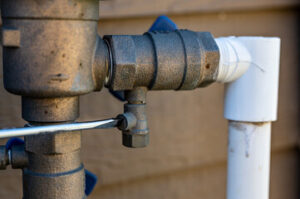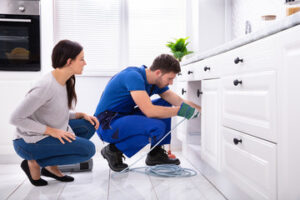Plumbing is the network of pipes, fixtures, and fittings that convey fresh water to homes and businesses. It also transports waste to sewer systems for disposal.

Without plumbing, we’d be stuck drinking river water and using outhouses for bathroom duties. Keeping your plumbing tip-top helps you avoid clogged drains and expensive repair bills. For professional help, contact Plumbing Express, Inc. now!
A backflow preventer is an essential piece of safety equipment installed in plumbing and other water-based systems around your home or business. It ensures that water flows in one direction and keeps contaminants from backflowing into the city water supply or your pipes. It is required in most multifamily residential buildings, commercial structures and industrial facilities but is often overlooked in single-family homes.
Backflow can happen in a number of ways. The most common are sudden dips in water pressure. This could be caused by a fire hydrant being opened for fire-fighting purposes, a broken water main, or even just a change in the demand for water due to weather conditions. When there is a drop in water pressure, it can cause potable (drinking) water to flow backward into the plumbing system. This can contaminate the clean drinking water in your plumbing pipes with sewage or other contaminants that can cause illness.
The backflow preventer keeps the water flowing in only one direction by ensuring that water can only enter your home’s piping from the city public water supply. It works by installing a series of one-way valves or vacuums on the incoming water lines that will stop the flow of water if it ever starts to flow backward. The three main types of backflow preventers are (1) double check valve assemblies (DCVA), (2) Reduced Pressure Zone Assembly (RPZ) and (3) air gap devices.
These backflow prevention devices have different designs based on the severity of backflow they are designed to handle. All of the different types have two one-way valves for redundancy and a low-pressure chamber that is sealed by these two check valves. If the pressure inside that low-pressure chamber gets too high, which would be a sign of backflow, a pressure relief valve located between the check valves will open and spit out any water in the system until the pressure in the pipe returns to normal.
The most basic type of backflow prevention device is an air gap, which simply creates a physical space where the potable and non-potable systems cannot connect. This is the most simple, inexpensive and effective way to protect against back siphonage and back-pressure.
Backflow Tester
Backflow testing is a necessary service that ensures your building’s backflow preventer device is working correctly. This device prevents dirty water from entering your clean water supply, which could threaten your health and safety.
In order to keep your water safe and sanitary, the backflow preventer needs to be tested every year. Licensed backflow testers are trained to evaluate your device and perform the appropriate test. They can also identify any issues with your system, such as broken valves or faulty seals. They can then make the necessary repairs to ensure your backflow device is functioning properly.
The backflow preventer works by preventing contaminants from entering the municipal water supply through cross-connections. Contaminants may come from irrigation systems, fire systems, and even your household plumbing. These contaminants can include chemicals, medical waste, and even dirt. The backflow preventer stops this from occurring by allowing only clean water to flow through the city’s water lines.
This is done by a mechanical device that’s designed to reverse the direction of water flow in case of a backflow incident. This device can be damaged by debris or worn parts over time, so it’s important to have them tested regularly. Backflow testing is necessary to protect the public water supply from contamination and to keep your water safe for drinking and showering.
During the backflow testing process, your local Kiddco plumber will shut off the water at your property temporarily. They will connect their testing kit to the backflow preventer and use gauges to monitor the pressure changes. They will then open and close the valves in your backflow device while taking readings and recording the results of the test. Once the test is complete, they will re-start your water, fill out the required paperwork, and submit the results directly to PWSA.
It’s important to remember that annual backflow testing is a requirement by your municipality, so it’s best to schedule testing well ahead of time. If you neglect to have your backflow preventer tested, you may be subject to fines or even have your water service disconnected. PWSA will send you a notice when your backflow test is due, so be sure to plan accordingly!
Backflow Test Form
A backflow test is conducted by a certified backflow tester to ensure that the plumbing system’s backflow prevention devices are working properly. These devices prevent backflow from contaminating the public water supply with human waste, harmful chemicals, and other contaminants. During the test, the backflow prevention device is checked for proper functioning and reversal of flow. The test results are then recorded on a backflow test form and submitted to the relevant authority or entity responsible for record-keeping or regulation.
The specific individuals required to submit a backflow test report may vary depending on local regulations and requirements. In general, it is the responsibility of certified backflow testers and professionals who perform backflow testing to fill out and submit these forms. However, property owners or managers who oversee the plumbing of a commercial or residential property may also be required to submit these reports.
Creating and editing backflow test forms is simple with online backflow testing software, such as Formlink’s. The software makes it easy to create and edit PDF forms with fillable fields, text, images, and more. It also enables users to easily import files from their computer, cloud, or other external sources. Once the forms have been created, they can be shared via email or URL. Alternatively, they can be printed or saved to a file location on the computer.
When conducting a backflow test, it is important to follow the proper procedures and use the right equipment. For example, it is essential to use the correct gauge and ensure that all bleed valves are open before pressurizing the device. This will ensure that any dirt or debris is not flushed into the differential gauge, which can affect readings. Also, it is important to close the bleed valves immediately after pressingurizing the device to avoid leaks and damage to the gauge.
It is essential to have a licensed plumber test and install a backflow prevention device in your home or business. This is because proper testing requires that your water service be temporarily disconnected. A licensed plumber can ensure that your backflow test is done correctly and efficiently and will handle the disconnection for you, ensuring that your home or business will not experience any disruptions or interruptions during the process. If you would like to have a backflow prevention device tested or installed in your home or business, contact the licensed plumbers at Art Plumbing, Air Conditioning & Electric where quality and professionalism go hand-in-hand.
Backflow Installation
When the drinking water piping in your home connects to other plumbing fixtures or equipment, it creates what is known as a cross-connection. If these are not properly protected, contamination can occur if backflow occurs and the contaminated water reverses flow and enters the drinking water piping. In order to prevent this, backflow prevention devices must be installed. These are called backflow preventers, and they work by preventing non-potable water from flowing into the drinking water supply.
There are two kinds of backflow prevention devices that you can have installed in your property. The first type is a service protection assembly. This is installed at the point of use for a water user and comes under the control of your state’s adopted plumbing code. The other type is an internal protection assembly. This is installed in the building’s water piping system and comes under the control of your backflow prevention certification.
Once the backflow prevention device is installed, you must have it tested. This is a requirement for commercial properties like apartment and condominium buildings, restaurants, and other places where people are likely to drink the water. This test determines whether the device is functioning correctly and is stopping contaminated water from entering the system.
The process of testing the backflow preventer is relatively straightforward. First, you must shut off the water main and drain any water that is still in the pipes. Next, you will need to open all inlet and outlet drain valves on the backflow preventer and all test cocks. Make sure you leave all of these in a half-open/half-closed position to allow for full drainage. Finally, you will need to tag the backflow preventer with your name and date of testing.
If you do not have your backflow preventer tested annually, it is possible that contaminated water from a private well or even the city’s public water supply could backflow into your water line and affect your health. This is why it’s so important to have your backflow preventer tested by a certified backflow tester every year. Failing to do this may result in fines and even disconnection of your water service.
